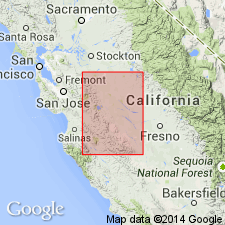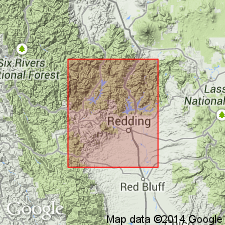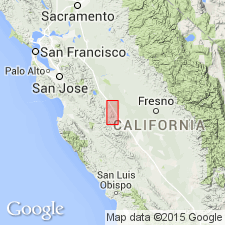
- Usage in publication:
-
- Panoche formation*
- Modifications:
-
- Original reference
- Dominant lithology:
-
- Sandstone
- Shale
- AAPG geologic province:
-
- San Joaquin basin
Summary:
Panoche formation. Lower formation of Chico group. Rests unconformably on Franciscan formation and is conformably overlain by Moreno formation, the upper formation of Chico group. Consists of alternating beds of dark thin-bedded clay shale and massive gray concretionary sandstone aggregating 9,500 to over 20,000 feet in thickness. The formation also includes some arenaceous shale, platy sandstone, and beds of coarse conglomerate, which locally attain great thicknesses. The lowest beds here included in Panoche formation are nonfossiliferous and may represent Knoxville formation, which, however is believed to be absent. Age is Late Cretaceous.
Named from development in Panoche Hills, Diablo Range, Fresno Co., southern CA.
Source: US geologic names lexicon (USGS Bull. 896, p. 1597-1598).

- Usage in publication:
-
- Panoche group
- Modifications:
-
- Revised
- AAPG geologic province:
-
- San Joaquin basin
Summary:
Pg. 1612. Panoche group. Upper Cretaceous Chico series subdivided into Gaines group (new), western Shasta County; Panoche group, Diablo Range; and Moreno group, Diablo Range. Panoche group, including Chico Creek and Los Gatos beds, has characteristic faunas in its upper one-third, but lower and major part is barren.
Source: US geologic names lexicon (USGS Bull. 1200, p. 2913-2914).
- Usage in publication:
-
- Panoche group
- Modifications:
-
- Areal extent
- AAPG geologic province:
-
- San Joaquin basin
Anderson, F.M., 1938, Synopsis of the Upper Cretaceous deposits [Chico series] in California and Oregon [abs.]: Geological Society of America Bulletin, v. 49, no. 12, pt. 2, p. 1863.
Summary:
Pg. 1863. Panoche group. Upper Cretaceous Chico series subdivided into three major groups: Pioneer (new), Panoche, and Orestimba (new). Panoche group best exposed on west border of Joaquin Valley, where it has average thickness of 14,200 feet on flanks of Diablo Range.
Source: US geologic names lexicon (USGS Bull. 1200, p. 2913-2914).

- Usage in publication:
-
- Panoche formation
- Modifications:
-
- Areal extent
- AAPG geologic province:
-
- San Joaquin basin
Summary:
Pg. 6 (fig. 2), 7, 8 (fig. 4), 12 (fig. 6). See also 1941 [abs.], GSA Bull., v. 52, no. 12, pt. 2, p. 1954-1955. Panoche formation. Underlies Dosados sand and shale member (new) of Moreno formation in type area of Moreno. Top is taken at same concretionary sandstone designated by Anderson and Pack (1915). Fossils [listed]. Age is Late Cretaceous.
Source: Publication; US geologic names lexicon (USGS Bull. 1200, p. 2913-2914).
For more information, please contact Nancy Stamm, Geologic Names Committee Secretary.
Asterisk (*) indicates published by U.S. Geological Survey authors.
"No current usage" (†) implies that a name has been abandoned or has fallen into disuse. Former usage and, if known, replacement name given in parentheses ( ).
Slash (/) indicates name conflicts with nomenclatural guidelines (CSN, 1933; ACSN, 1961, 1970; NACSN, 1983, 2005, 2021). May be explained within brackets ([ ]).

